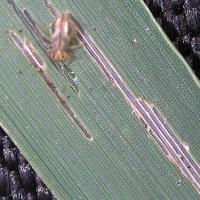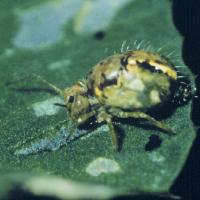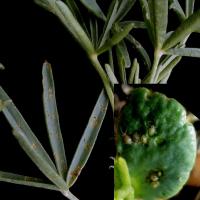Diagnosing lucerne flea
A pest mainly of young legume pastures and broadleaf crops but can also affect cereals. Commonly observed on loam-clay soils.
What to look for
- Small jumping bugs that appear early in the season and chew young leaves on heavier textured soils.
Paddock
- • Cereals, canola and pasture legumes have chewed leaves with transparent ‘windows’.
• Green material completely removed in severe infestations.
• Lupins and canola have pitted cotyledons.
• Lupins have chewed leaflet spots and edges.
Plant
- • Adults (3 millimetres) yellow-green, wingless and globular in shape sometimes with dark markings.
• Insects ‘spring’ off foliage when disturbed.
Insect Adult
Where did it come from?
- Lucerne flea is a European insect that is a pest on heavy soils in WA.
- It requires cool, moist conditions and will produce up to five generations in most years with the final generation of females each season laying eggs that over-summer in the soil.
- The first soaking autumn rains cause over-summering eggs to hatch.
- Broadleaf weeds, particularly capeweed, favour lucerne flea
Management strategies

Spraying insecticide
- Apply systemic or contact insecticides.
- Do not use synthetic pyrethroid sprays as these are ineffective against lucerne flea.
Economic and financial considerations
To assist in assessing the economic risk and financial costs associated with various treatment strategies go to MyEconomicTool
There may be other economic and financial implications that need to be considered when choosing a management option. These may include:
Pre-crop- Understand the potential yield losses associated with lucerne flea feeding damage.
- Assess the costs and benefits of taking preventative action.
- Assess the cost and benefits of controlling summer weeds to reduce potential feed sources for fleas.
- Compare the costs, benefits and risk of each management option against doing nothing.
- Consider risk and associated costs or savings of no treatment or delaying treatment.
- Ignore all previous treatment costs in assessing current management options.
- Continue to monitor.
View these economic considerations in more detail.
Page last updated: Friday, 26 August 2022 - 2:04pm





